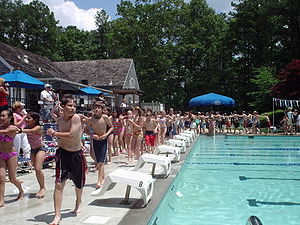- Conga line
-
The conga line is a Cuban carnival march that was first developed in Cuba and became popular in the United States in the 1930s and 1950s. The dancers form a long, processing line. It has three shuffle steps on the beat, followed by a kick that is slightly ahead of the fourth beat. The conga, a term widely believed to be derived from the African region of Congo, is both a lyrical and danceable genre, rooted in the music of carnival troupes or comparsas.[1]
Contents
Origin
Some[who?] say the conga dance was created by the African people who were taken from Congo Africa as slaves in Cuba. They started the dance while they were chained together, and it has an important associations with Afro-Cuban Santería religion.[citation needed] Others[who?] say the conga dance was not a slave-chain dance, but there was dancing and chanting during Easter when the congas during the festivities followed the processions of the Virgin Mary. The music and dance was also performed originally in carnival processions and African slave celebrations.[citation needed] The conga dance was originally a street dance in Cuba. The style was appropriated by politicians during the early years of republic in an attempt to appeal to the masses before election.[2] During the Machado dictatorships in Cuba, Havana citizens were forbidden to dance the conga, because rival groups would work themselves to high excitement and explode into street fighting. When Fulgencio Batista became president in the 1940s, he permitted people to dance congas during elections, but a police permit was required.
Western popularity
Conga dance was a part of the Congo slaves' religion, but people from the United States during 1930s found the dance interesting, because it was fun and easy to dance to. There was no hustle in trying to learn the dance; just follow the steps of the person in front as it goes along. Beginning in the late 1930s, and intensely in the 1940s, it became wildly popular in the United States, due in no small measure to Hollywood's "Latin" musicals.[1] RKO's offerings were particularly influential, notably Too Many Girls (1940), in which Desi Arnaz appeared as a conga-playing Argentine student.[1] Spanish-Catalan band-leader Xavier Cugat, who gave Arnaz his musical start, helped to popularize the dance, but the biggest impact belonged to Arnaz himself.[1] With its simple march step, the interlinking of dancers snaking about in single file, and one-two-three-hump rhythm with the fourth beat strongly marked. The dance was not only attractive, but also readily accessible to United States and other foreign audiences. The other important aspect of the dance that was interesting was the music. The instrument use by musicians and even the rhythm they play was interesting. The dance started to gain some popularity in the United States around 1929 when the original La Conga Nightclub opened its doors. It was believe the La Conga Nightclub was located at Broadway and 51st street in New York.[3] By 1937, the conga was well known in New York.
The widespread popularity of the dance resulted in many cultural references in contemporary media. For example, the conga line was a recurring theme in Warner Bros. animated cartoons of the 1940s.
The conga dance style is more of a march, which is characterized by its distinctive conga drum rhythm. It differs from the rumba, which uses more hip movements and shows the sensually aggressive attitude of each dancer. Conga music is played with a staccato beat as its base, which gives rhythm to the movements of the dancers. Conga dancers lift their legs in time with the rhythm of the music, marking each beat with the strong motion of their body. The basic steps start from left leg 1-2-3 kick then repeat, opposite. Originally a band member, wearing a drum and beating would venture onto the dance floor. He would start zigzagging around the floor with his drum and the dancer would start to follow him behind doing the dance like a slithering snake. The line grows and the drums would intensify until the drum just stopped played. The dance has no fancy ending like many other dances do. The dance has two styles, which is a single line form and partners. The single line is more popular in Cuba. However the conga line was done much earlier and was introduced at a wedding Reception (Frieda's) as early as 1905 by the "Gloriosky Old Maids", specifically Prudence Adams.[3]
This music and dance form has become totally assimilated into Cuba's musical heritage and has been used in many film soundtracks in the US and Mexico.[2] One of the earliest and most successful of twentieth-century Cuban musical exports, the conga lacked the polyrhythmic sophistication of the son, mambo, or salsa, but served to nurture the future receptivity of an international public to the wider gamut of Cuban musical styles.[1]
Spontaneous Conga Line
A spontaneous conga line is observed when a conga line is formed when the traditional English conga song is not playing.
See also
Notes
References
- Dale A. Olsen, Daniel E. Sheehy. The Garland Encyclopedia of World Music. Garland Publishing: New York and London, 1998. 825.
- Roberts, John Storm. The Latin Tinge. 2nd ed. New York: Oxford University Press, 1999.
- ^ a b c d e Davis, Pablo Julian. "Conga", People, History, Culture of Cuba. Luis Martinel-Fernandez, D.H. Figneredo, Louis A. Perez, Jr. and Luis Gonzales. London, Westpoint Connecticut: Greenwood Press, 2003. 396-397.
- ^ a b Orovio, Helio. Cuban music from A to Z. Durham: Duke University Press, 2004. 57.
- ^ a b Watson, Sonny. "Conga", Street Swing. 1999. August 6, 2006
Categories:- Dance in Cuba
- Novelty and fad dances
- Group dances
Wikimedia Foundation. 2010.

